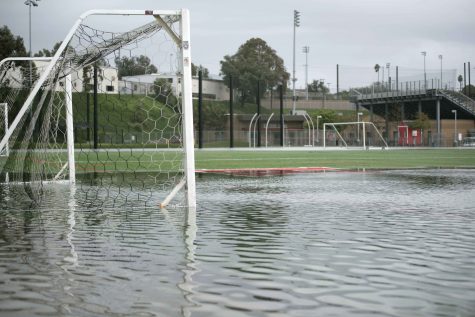“Lake Redondo”: Recent rain floods the practice field

The practice field experienced severe flooding last week.
Making up most of the practice field, the high school’s newest body of water—jokingly nicknamed by students as “Lake Redondo”—has become a temporary product of flooding as a result of excess rainfall.
The consistently backed up retention bins cannot hold the set amount of rainfall that RUHS has received. Recharging the groundwater aquifer would help free up space in the bins, ultimately draining the flooded field.
“The retention bases underneath the field were adjusted to a hundred year flood system, meaning it could only retain enough water for a flood every hundred years,” teacher Gillian Moberg said. “But even a flood like this one is too much for the drains to hold causing the water to back up.”
Moberg says the drains are functioning “properly” and holding the amount of water they are designed to in contrast to the excess amount of water Redondo has been receiving.
“The water storages underneath the ground function as a typical aquifer would and therefore instead of running off into the ocean and become saltwater, which would be a waste, it is stored underground as freshwater,” Moberg said.
Moberg believes the storage bins are “crucial” to our drinking water supply, such as a well, because then Redondo wouldn’t have to spend more money importing water from places such as northern California.
“I don’t think that the drains should be rebuilt to retain more water because this is sort of a freak event,” Moberg said. “I think it’s leftover from the El Niño that was supposed to come but it could be postponed up to now. So this could be the tail end of a weakened storm.”
It is too early to start constructing a new water storage plan, Moberg believes, because this amount of rain doesn’t occur in southern California often. Although if heavy rainfall were to become a bigger issue, she believes that it should be dealt with in the future.
“We can never prevent all the floods that goes on at the school but it’s certainly something for a civil engineer to look into,” Moberg said.
Moberg believes that a new storage bin could still lead to a flood and doubts that it will hold enough water. In hindsight, Moberg believes it is too “premature” to start devoting the dollars to building a new storage bin.
“We could also look into moving some field based sports inside instead of trying to engineer our way around everything since it would be quite costly,” Moberg said.
Athletic Andy Saltsman admits the excess flooding has taken a “toll” on some of the sports teams such as lacrosse and soccer.
“Ultimately, it’s out of our control,” Saltsman said. “Because the fields are at a slope, all the water rushes to the field and collects, hindering the ability to play sports on the fields.”
Saltsman agrees with Moberg that because the field flooding is a “once in a while” event, for the days of the field’s flooding, the teams should work their way through it rather than construct a new water storage bin.
“At this point some of the sports have been negatively affected in terms of practicing,” Saltsman said. “We even had to cancel the games that we were supposed to play due to the flooding.”
Due to the cancelled practices, some students have utilized the field flooding to their own advantage.
“My friends and I first got the idea to go skimboarding on our way to volleyball practice and right after school we went in the fully flooded field,” sophomore Thunder Bird said.
Bird has no regrets about going skim boarding and positively believes the flooded field has given him a “fun” way to skimboard.
“Since it was after school, we didn’t get in trouble,” Bird said. “But quite honestly the whole experience was great.”
Saltsman believes the student’s newfound recreational use of the field is very “interesting” and is “ironic” that the field can still be used despite the flooding to be skimboarded on.
“For a safety and liability issue, I do not condone the behavior of skimboarding and putting the students at risk of harm,” Saltsman said. “Yet from a fun and exciting behavior, as long as the students aren’t doing it during school hours then it shouldn’t be a problem.”
While many students believed that the flooded field was “fun,” STEM class Biomedical Innovations tested water from the field and found Coliform bacteria present. Types of Coliform bacteria include Hafnia, Citrobacter freundii and E. Coli.
“Anytime there is still water in the community, not just limited towards the school, it’s not recommended to play in it, especially if it’s contaminated,” principal Jens Brandt said. “There are a variety of symptoms that could result from being in infested water, so students should stay away from the flooded areas for their own safety.”
Playing in contaminated water could cause students to get sick.
“Side effects of being in the water such as nausea, diarrhea and vomiting could put you out of school for a couple days which can become a major health emergency with the possibility of being hospitalized,” Brandt said.
Although the flooded field was a source of “fun” for a few students, Bird sympathizes for the teams who couldn’t be able to play and practice.
“It was the most fun I’ve ever had during volleyball practice although I kind of feel bad for the other sports teams who weren’t able to play due to the flooded field,” Bird said.
In the fifteen years that Moberg has been at this school, she believes that rainfall is “unprecedented” to have had this much of an effect on the campus.
“With climate change, we are faced with a lot of unpredictable weather such as the excess amount of rain we have been experiencing so far,” Moberg said. “So ultimately, how do we prepare ourselves for this? How do we predict the unpredictable?”

Aiwreckuh
Live fast die yung (almost 16 years, going strong)
Stay classy not sassy. Rawr XD
04.12.01 with my main homie (me)



